- eISSN 2353-8414
- Tel.: +48 22 846 00 11 wew. 249
- E-mail: minib@ilot.lukasiewicz.gov.pl
Praktyki społecznej odpowiedzialności biznesu w branży energetycznej — tendencje zmian
Mirosława Pluta-Olearnik1, Aneta Buda2
1Department of Marketing, Wroclaw University of Economics and Business, Komandorska Street 118/120, 53-345 Wrocław, Poland
2Faculty of Management, Wroclaw University of Economics and Business, Komandorska Street 118/120, 53-345 Wrocław, Poland
*E-mail: miroslawa.pluta-olearnik@ue.wroc.pl
Mirosława Pluta-Olearnik: ORCID: 0000-0002-5719-4710
Aneta Buda: ORCID: 0009-0002-0020-4022
DOI: 10.2478/minib-2023-0003
Abstrakt:
Celem artykułu jest analiza i ocena praktyk społecznie odpowiedzialnego biznesu jako odpowiedzi przedsiębiorstw na oczekiwania szerokiego grona interesariuszy. W artykule autorki postrzegają praktyki CSR jako sposób na prowadzenie działalności rynkowej w zgodzie z oczekiwaniami interesariuszy, niebędące jednorazowym aktem, lecz ciągłym zmierzaniem do poprawy obszarów otoczenia przedsiębiorstwa wymagających wsparcia, a podmiotem wybranym do analizy jest polska grupa kapitałowa branży energetycznej Grupa Energa. Jest to duży podmiot, którego działania mogą w znacznym stopniu i na wiele sposobów wpływać na otoczenie. Analizy oparto na źródłach wtórnych, w tym zwłaszcza cyklicznych raportach CSR oraz sprawozdaniach niefinansowych Grupy Energa. Wyniki badań ukazują tendencje zmian praktyk CSR w analizowanym przedsiębiorstwie na przestrzeni ostatnich dziesięciu lat 2011–2021 i mogą być wykorzystane w formułowaniu kolejnych programów CSR Grupy Energa oraz stanowić inspirację dla innych podmiotów.
MINIB, 2023, Vol. 47, Issue 1
DOI: 10.2478/minib-2023-0003
Str. 31-48
Opublikowano 31 marca 2023

Praktyki społecznej odpowiedzialności biznesu w branży energetycznej — tendencje zmian
Introduction
Introduction
Proper communication with stakeholders is now one of the fundamentals of strategic management of enterprises. Corporate social responsibility programmes, which have been developed for many years, fit well into this trend, creating a kind of bridge for the use of certain resources at the disposal of companies in accordance with the expectations of stakeholders.
The purpose of the article is to analyse and evaluate corporate social responsibility practices as a response of enterprises to the expectations of a wide range of stakeholders. In the article, the authors perceive CSR practices as a way of conducting market activities in accordance with stakeholder expectations, with those not being a one-time act but a continuous effort to improve areas of the company’s environment
requiring support. Noticeable activity in CSR programmes is shown by entities belonging to the energy industry, including the Energa Group, which is one of the key players. There are several major electricity suppliers and sellers in Poland. These are, besides Energa Group, primary entities: Tauron Group, PGE Capital Group, Enea Capital Group and E.ON Polska S.A. There are also many other alternative players in the industry whose scale of operations in Poland is far smaller than that of the above five mentioned entities. They include Fortum Power and Heat Polska Sp. z o.o., Audax Energia Sp. z o.o., Engie Polska Sp. z o.o. and Enefit Sp. z o.o. All of the listed entities carry out activities in the area of corporate social responsibility, but their scope varies.
The entity selected for analysis is a Polish capital group of the energy industry, i.e., Energa Group. It is a large entity whose activities can significantly and, in many ways, affect the environment. The analysis was based on secondary sources available to the public, that is, reports on the activities of the Energa Group by the Board of Directors, 'Our responsibility’ reports published from 2012 to 2020 and the Energa Group’s non-financial information reports for 2020 and 2021. The results of the data analysis show the trends of changes in CSR practices in the studied company over the last 10 years (2011–2021), which can be useful in the development of the Energa Group’s CSR programmes and indicate the directions for other business entities involved in CSR programmes.
For the purpose of the research objective, the following research questions were formulated:
- With what metrics can a company’s involvement in CSR activities be analysed in the long term?
- What trends of changes in the studied CSR categories can be observed, taking into account the analysed long period?
- What are the possible reasons for changes in the dynamics of the studied values describing CSR activities over the analysed period?
Corporate Social Responsibility — The Evolution of Approaches
Table 1 shows the evolution in the understanding of activities referred to as Corporate Social Responsibility (acronym CSR) based on a review of research achievements.
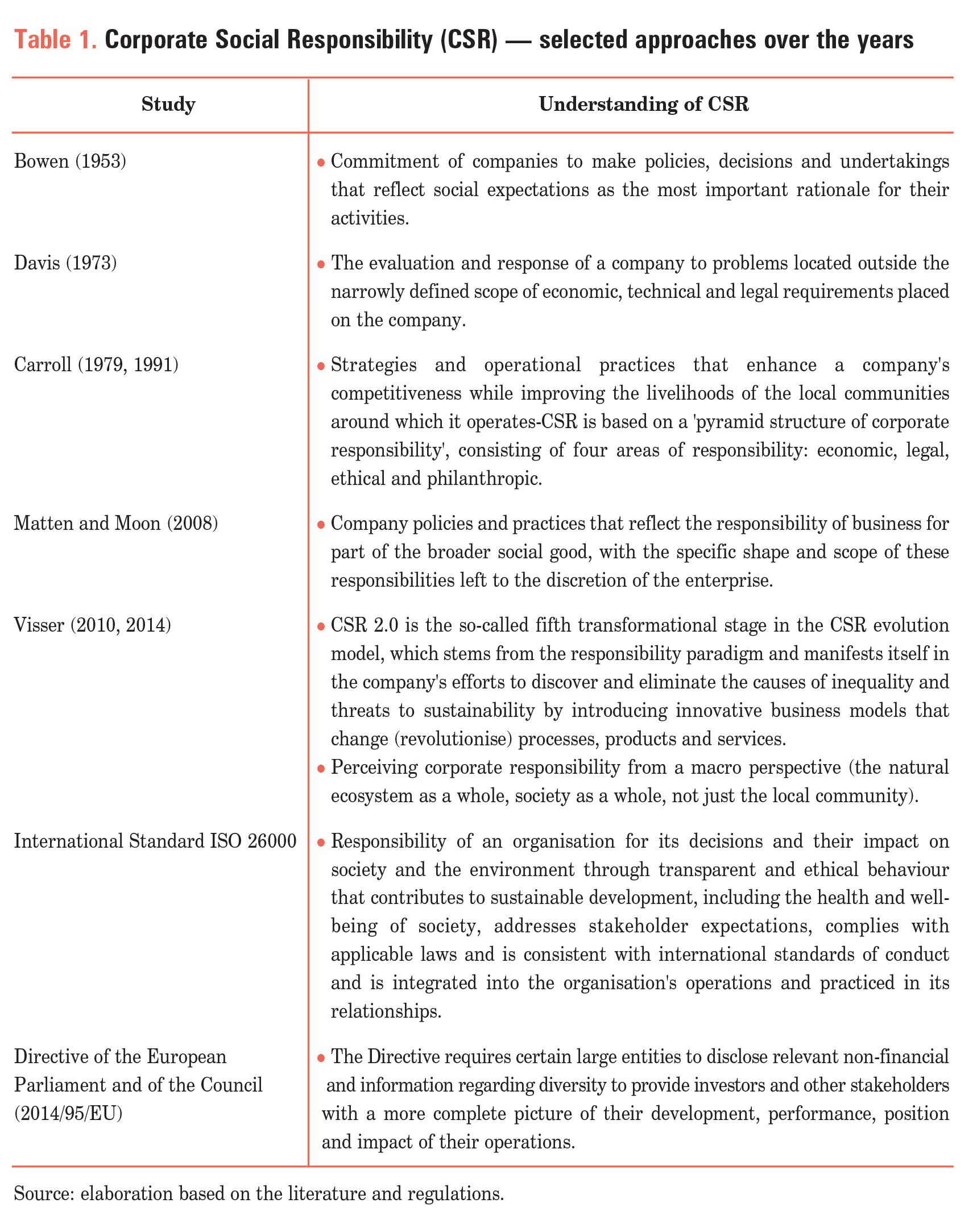
As can be seen from a review of the content included in Table 1, the concept of CSR is complex and multidimensional in nature. The concept of CSR is mainly about a company 'being responsible’ for its actions and focusses more on sharing the company’s profits with the environment than on creating an economic value. A company creates social value’ by addressing the needs and problems of the society (Porter & Kramer, 2011a, 2011b). The concept of CSR 2.0, according to Visser, stands for an innovative approach to business and the use of the gains of new technologies, including social media, for dialogue. CSR 2.0 is based on five principles: creativity (creativity), scalability (scalability), responsiveness (responsiveness), glocality (’think globally, act locally’) and circularity (circularity or closed loop leading to total resource recovery). Visser points to the need for a new reading of the CSR acronym as corporate sustainability and responsibility. This formula for reading the abbreviation CSR is to emphasise that sustainability is the goal and responsibility defines how to get there (Visser, 2014; Spyra, 2022). In addition, Table 1 indicates documents standardising business responsibility practices (ISO standards) and EU regulations on corporate sustainability and CSR reporting.
To sum up, there is an evolution of the conceptual scope and role of the CSR concept in corporate strategy, which proves the validity of this approach for modern business. In order to seek answers to the formulated three research questions, the authors undertake a more detailed analysis based on quantitative data and on the CSR activity of a selected energy industry company.
Research Methodology — Criteria for Selecting data Describing the CSR Activities of the Company
For the purpose of analysing the dynamics of CSR activities, it is necessary to have data expressed in numerical terms to determine the relationship between these values in the various periods under study. The main criterion that needs to be taken into account in the selection of data is their availability. This is especially important for those data whose publication is voluntary, which leaves room for choice for entities deciding to publish the information of their choice. However, this information can be systematised through the use of standards and benchmarks (including the Global Reporting Initiative [GRI] guidelines, which provide an international benchmark for companies to report on responsible business and sustainable development).
Some entities, including the Energa Group, are subject to statutory obligations to disclose non-financial information, among which are activities relating to CSR. These include information on the entity’s policies relating to the environment, anti-corruption or respect for human rights, as well as those relating to social and labour areas. An important criterion for the selection of quantitative data is also the continuity of the publication of these data, which allows the phenomena and their changes over time to be shown reliably and as closely as possible to reality. Regularity of data publication is also an important aspect, ensuring comparability of information over time. Regularity, however, refers to data relating to those CSR activities of a company that are carried out on a repetitive or continuous basis.
In the context of the search for and selection of source materials, their reliability is important, crucial to ensuring the reliability and objectivity of the analyses conducted. Some corporate reports, particularly those of a mandatory nature, are subject to examination by external auditors. In contrast, reports published on a voluntary basis, among which are social and sustainability reports, are usually not subject to external verification. However, conducting regular, detailed examinations of non-financial information by an external entity in the way that is done for financial data would be labour intensive and difficult to implement (Matuszyk, 2018). Some of the information may be published selectively, presenting only favourable data. It is therefore also important to make the data comparable over time so that regardless of whether it presents itself in a desirable way, it is possible to view it and compare it objectively with data from other periods.
Based on the literature study, categories of CSR activities were identified, which made it possible to systematise the wide range of activities that make up socially responsible practices. The designated categories helped us to organise the activities undertaken by the studied energy industry entity. As a result of the analysis of reports published by the Energa Group, the scope of the entity’s social responsibility data included in the published documents was established.
Corporate reporting is the primary source of data on the entity’s operations. Energa S.A., as the parent company of the Group, is required to prepare periodic financial statements, reports on operations and reports on non-financial information. The Energa Group’s financial statements do not address corporate social responsibility issues. Instead, these issues are present in the Board of Directors’ reports on the Energa Group’s activities, where they were presented in a concise, descriptive manner. The most extensive and detailed CSR issues were described in the separate Our Responsibility reports published in 2012–2020 and in the Energa Group’s non-financial information reports for 2020 and 2021. Both documents were prepared in accordance with the GRI reporting standard. The frequency of publication of these reports is 1 year.
It should be emphasised that business entities are obliged to report non-financial information as defined by Directive 2014/95/EU and implemented into the Polish legal order by the Act on Amending the Accounting Act of 15 December 2016. (Journal of Laws of 2017, item 61). Significantly, on February 24, 2022, the EU Competitiveness Council adopted the so-called 'general approach’ to the draft directive on corporate sustainability reporting. The new directive is expected to replace existing EU regulations on the disclosure of non-financial information; uniform European reporting standards will be developed, as well as a simplified version for smaller entities.
In the process of in-depth analysis of the content of Energa Group’s reports, metrics were selected to indicate changes and trends in CSR activities over a 10-year period. In the case of the Energa Group, the selected metrics characterise the entity’s CSR activities quite well but do not provide a comprehensive snapshot of the activities carried out. The reason for this is the limitations of the company’s lack of use of a number of potential metrics that capture the nature of CSR in the model approach proposed in the literature. However, the metrics selected for analysis are useful in monitoring the effects of CSR practices in the Energa Group, thanks to the possibility of collecting quantitative data over a relatively long period and maintaining continuous monitoring.
Assumptions of Analysis of CSR Activities of Energa Group in 2011–2021
It should be noted that much of the information on socially responsible activities and their effects is presented by the Energa Group in a descriptive manner, while the quantitative data necessary for the analysis were finally collected in three possible categories: environment, employees and society. Table 2 presents a summary of published quantitative data that are measures of CSR for the analysed entity, taking into account the availability of data over time as a basis for determining the continuity of their publication.
Tabular visualisation of the availability of sources in the years indicated allowed us to extract data that maintain temporal continuity over specific years, as well as determine the length of the period over which the data was published. Variables can be divided into those characterising CSR in the area of environmental impact (items 1–4) and those variables relating to activities aimed at people, in this case employees (items 5–7) and communities (items 8–12). The study of the dynamics of changes in the phenomenon over time made it possible to determine the nature of these changes and to isolate trends of change.
The study included several stages, the implementation of which made it possible to answer the research questions. First, measures were selected that characterise CSR on the basis of the established criteria. Second, among the proposed metrics, those characterised by continuity over time and a sufficiently long period of data availability were extracted. Third, the dynamics of the determined variables were examined using several methods of time series dynamics analysis. These methods aim to determine what is the intensity of changes in the level of the analysed phenomenon and their direction over a certain time interval (Balcerowicz-Szkutnik, Sojka, & Szkutnik, 2014).
Given the volume of the study, in the following section, we will focus our attention on the variables of selected activities directed to the stakeholders of the Energa Group company defined as communities.
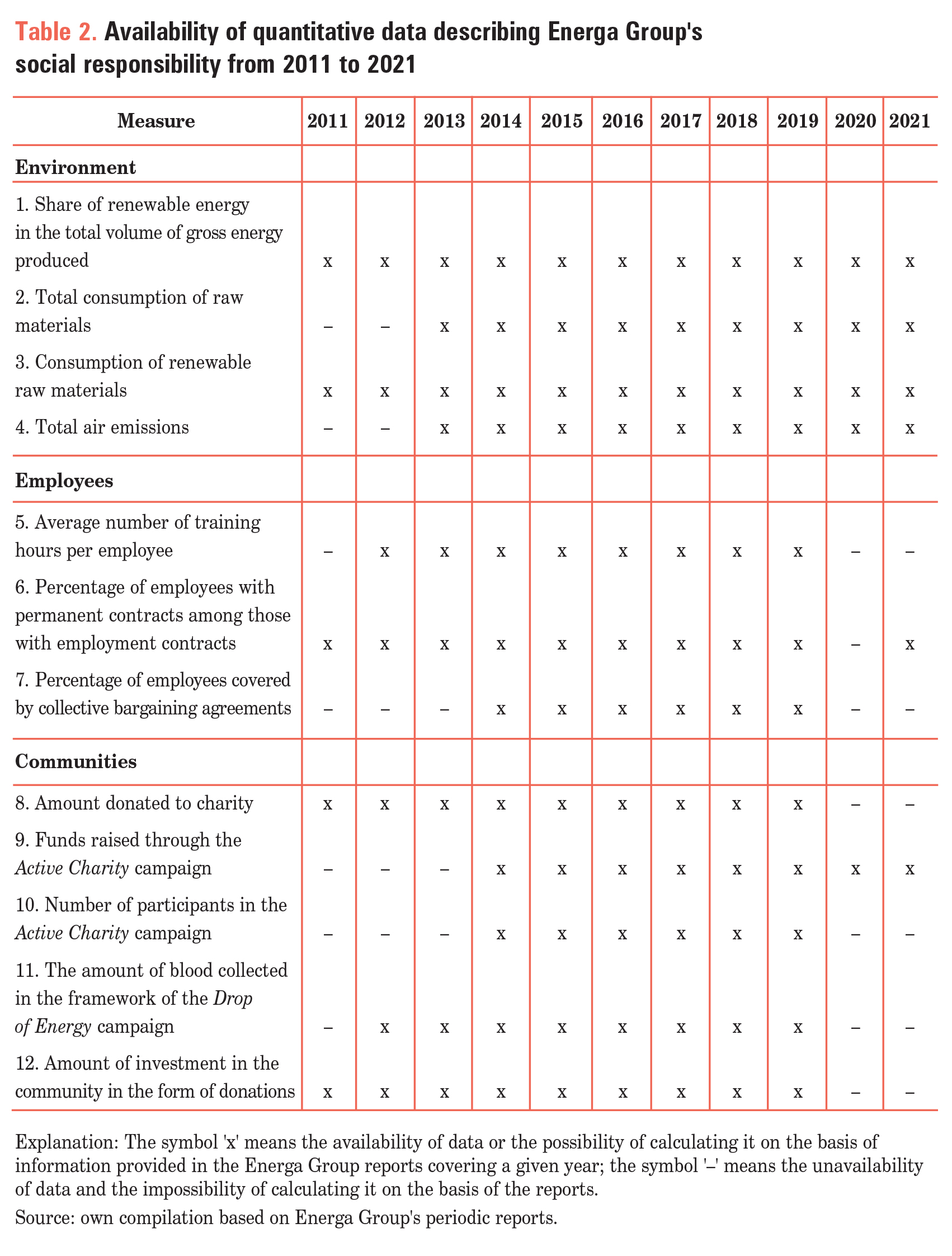
Analysis of Energa Group’s Social Activities
According to the information in Table 1, the Energa Group’s activities initiated under social responsibility and aimed at communities can be analysed using six metrics: the amount of money donated to charity, funds raised through the Active Charity campaign, the number of participants in the Active Charity campaign, the amount of blood collected through the Energy Droplet campaign and the amount of investment in communities through donations. The first CSR measure analysed is the amount of money that was donated to charity by the Energa Foundation. These amounts and their dynamic indexes are presented in Table 3.

The amounts donated to charity were at similar levels in 2012–2015, while the single-basis index values of >1 during 2016–2019 indicate higher amounts of support in this time frame than in the base year (2011). These were the highest values in the analysed period. The varying values of the chain indices indicate irregular changes.
Another variable in the social area relates to the organised Active Charity campaign, and the amount of funds raised through this campaign
was analysed. The formation of the variable is shown in Table 4.
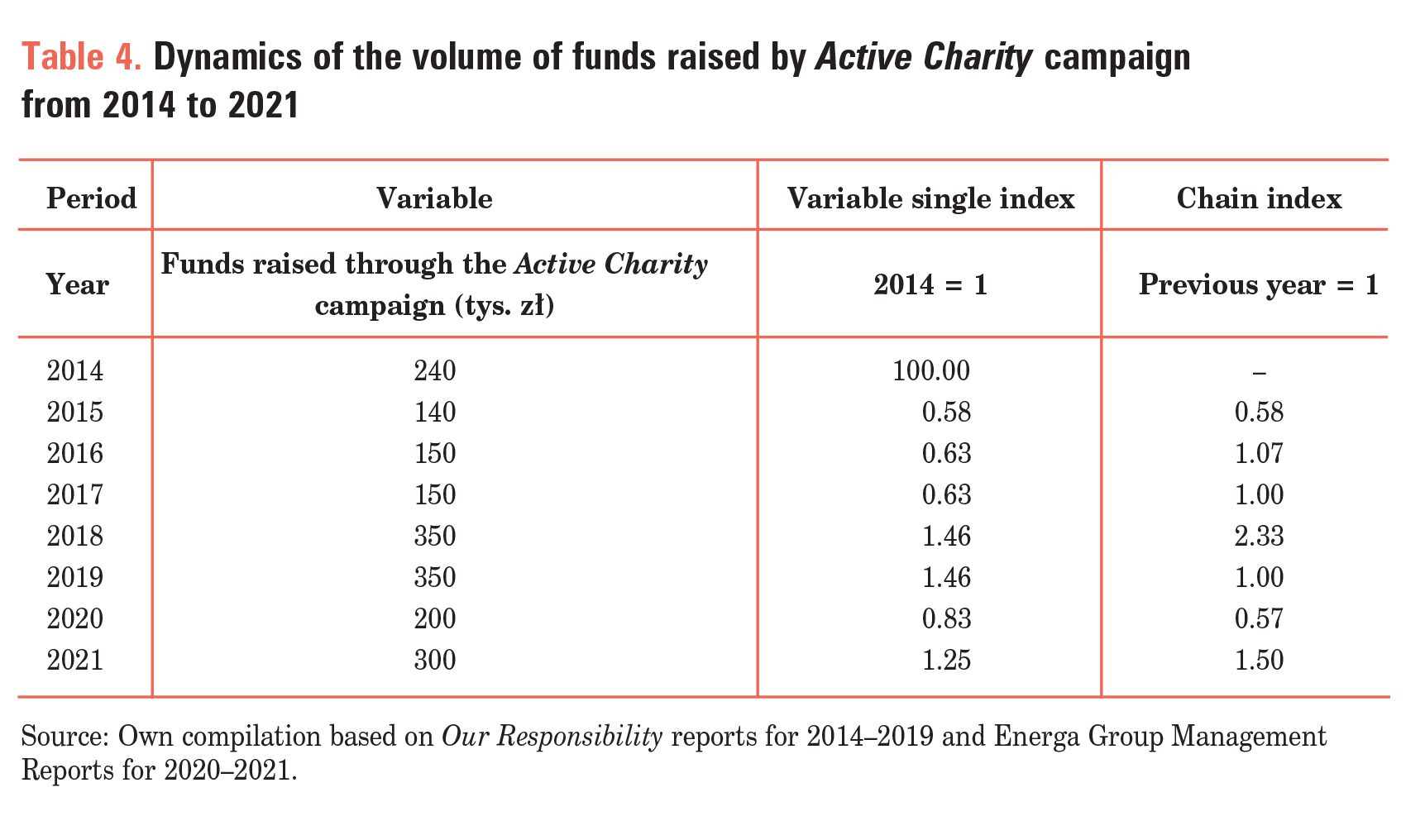
The amount of funds raised under the initiative varied and is not characterised by a clear trend of change. The biggest change took place in 2018, when the amount of funds was 133% higher than that of the previous year. Interest in the above initiative can be illustrated by the number of participants, the dynamics of which are shown in Table 5. As for the number of participants in the initiative, there is a clear upward trend over the period under review. On average, the number of participants increased by 21% per year, which should be evaluated favourably. The highest value of the variable, which occurred in 2018, increased by 200% compared with the beginning of the analysed period (2014). It is possible to see a systematic increase in the variable from 2016 to 2018, as evidenced by small differences in the chain indexes from this period.
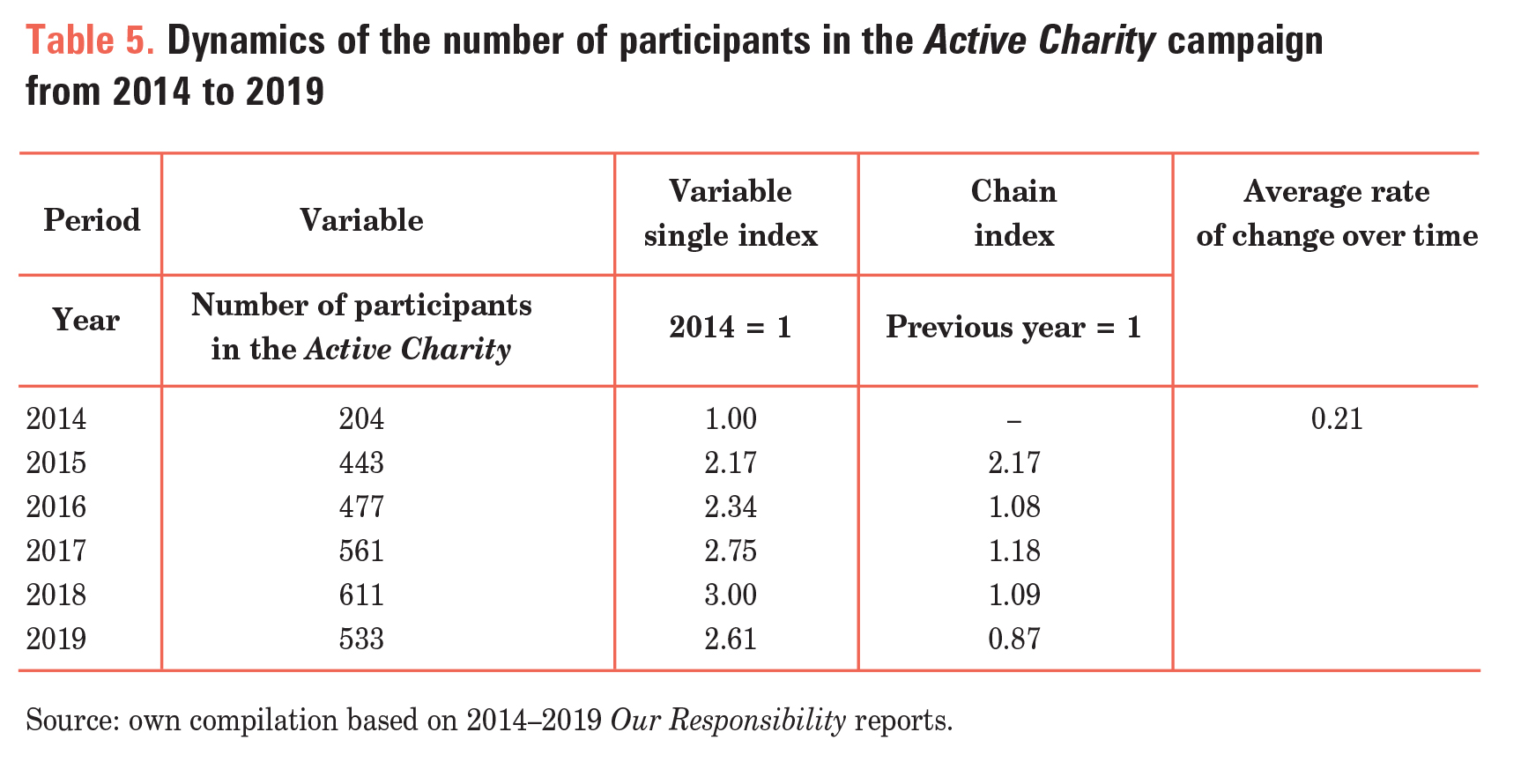
The next analysed measure of the Energa Group’s CSR is the amount of blood for needy patients collected during the Energy Droplet initiative. Table 6 shows the development of the variable and its dynamics.

In the first year of the Energy Drop campaign initiative and during the first period of data availability, the initiative’s effectiveness was low compared to subsequent years. In subsequent years, however, the amount of blood collected gradually increased, as evidenced by the high values of the single-base and chain indexes. The number of litters of blood collected increased by an average of 45% per year; so, the initiative was very popular.
The last variable analysed is the amount of investment in communities in the form of Energa Group donations. The development of this variable and the dynamics of change are shown in Table 7.
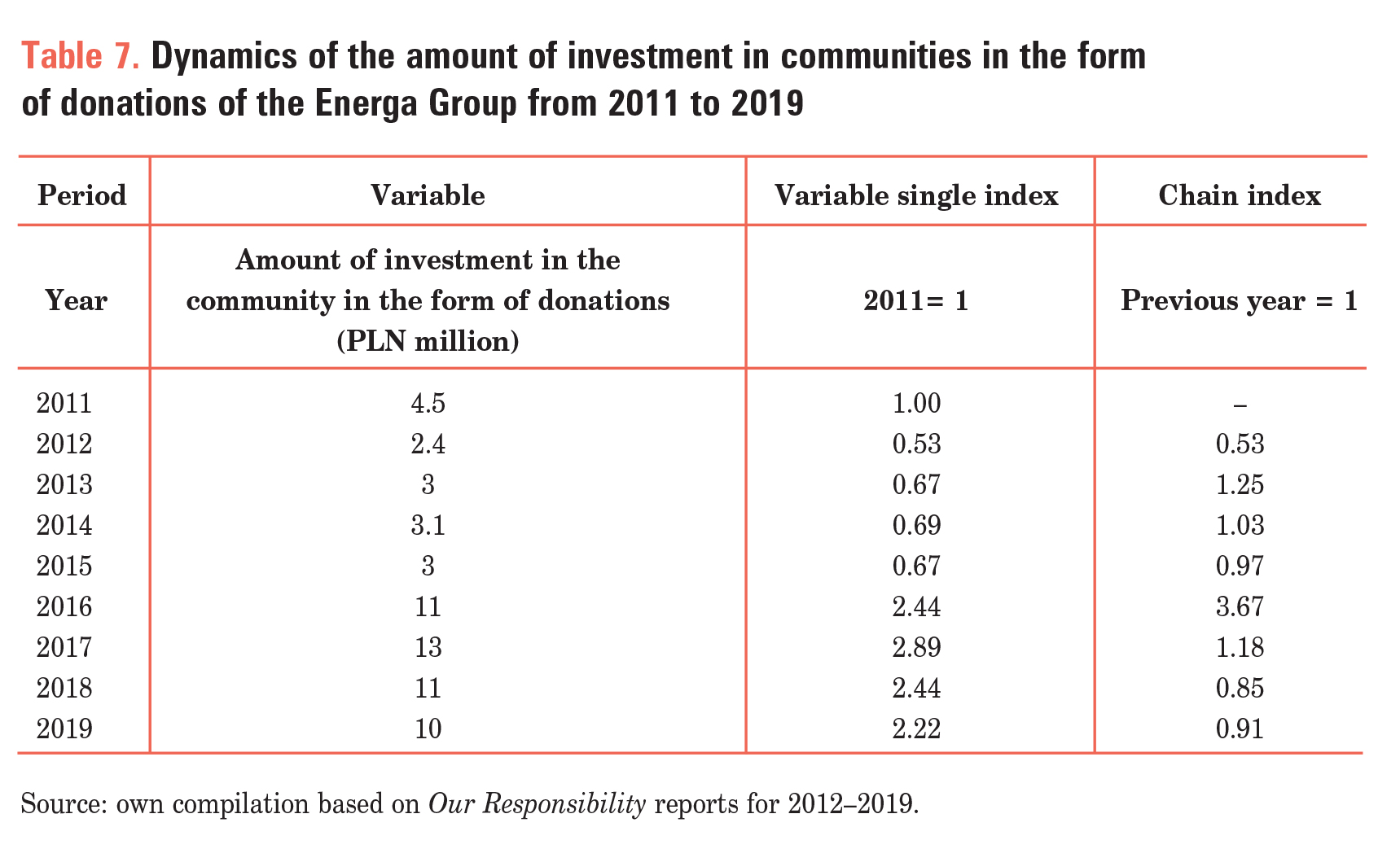
It can be seen that there is a clear difference between the values of the variable in the 2011–2015 periods, when the single-chain indices showed values below 1, and the values are variable in 2016–2019, when the indices were much higher and exceeded 2. This means that compared with the base year, the amounts of donations increased by >100%. The amount of donations made in 2016 increased by 267% compared with 2015, which was the largest recorded increase for the chain indexes.
Discussion of Research Results
An analysis of the dynamics of CSR activities of a social nature shows its varied course. First of all, it should be noted that 2018 saw the acquisition of the CSR Foundation, previously operating within the Energa Group, by the Energa Foundation. This may have influenced possible changes in the disposition of CSR budget funds, but to a large extent, the amount of funds at the Foundation’s disposal depended on the revenue raised from the main funder, Energa SA, which directs its 1% income tax annually to the Energa Foundation. Depending on the Foundation’s budget possibilities, it was possible to allocate these funds to projects on its own initiative and to individual support for those applying for them.
As for the Active Charity initiative, the dynamics of CSR activities was described by two measures: the amount of funds raised for charity and the number of participants. The dynamics of the two metrics developed differently. The increasing number of participants in the initiative indicates the effectiveness of the promotion of this action among employees, their relatives and friends. The amount of support provided to childcare centres and other similar institutions did not result directly from the distance covered by participants in the physical activity but depended on the stated goal of the support and the funds available for this purpose.
The dynamics of the activities of the Energy Drop campaign followed a similar pattern. The amount of blood collected and, at the same time, the number of people involved in the campaign increased markedly among all analysed variables. The Energy Drop campaign has been promoted in social media since 2016, promoting the idea of blood donation and educating people about it, while dispelling myths about the issue of blood donation. The initiative’s Facebook profile posts all information about blood donation events. This had the effect of almost doubling the amount of blood collected in 2016 compared with the previous year, when the initiative was not so actively promoted through Facebook. Communication with potential blood donors can be considered effective, given the high dynamics of the amount of blood collected.
The last measure analysed in the social area was the amount of community donations made by the Energa Group. In 2016, we saw the steepest increase in this variable compared with previous years. At that time, the Group supported numerous initiatives under the Energa for You programme aimed at local communities, and the value of donations made under the Help with Energa initiative also increased. However, the reports do not detail the amount of funds donated to communities not resulting from programmes promoted by the Group, which would explain such a significant increase in the amount of donations made in 2016 compared with previous years.
Conclusions
The year 2020 was the outbreak of the COVID-19 pandemic, which naturally caused a number of difficulties for companies in many industries. This also affected the operations of the Energa Group, which was forced to adapt to the new reality, for example, new remote customer communication systems were implemented. Despite the difficulties associated with the pandemic, the Group did not reduce spending on support for local communities, as they are an important part of the entity’s budget policy. A large part of the pro-community projects was related to pandemic support. Among them was the Remote Education with Energy project, which provided training for school staff in effective remote teaching. Numerous donations were also made to combat COVID-19-targeting medical facilities.
In conclusion, although the Energa Group has been reporting on its corporate social responsibility activities for years, it is not always possible to make a quantifiable assessment of each area of this activity in which the CSR concept manifests itself. The Group has implemented many programmes and projects, which definitely positively affect its image among internal and external stakeholders. The Group’s reports satisfactorily and transparently show the changes in the effects of the Active Charity and Energy Drop initiatives implemented. The effects of many other initiatives could also be presented in a similar way, showing their continuity and consistency in the Group’s operations. The growing popularity of regularly organised charitable actions can have a very positive impact on the Group’s image as socially responsible.
References
1. Balcerowicz-Szkutnik, M., Sojka, E., & Szkutnik, W. (2014). Statystyka opisowa dla ekonomistów. Przykłady i zadania. Katowice, Poland: Wydawnictwo Uniwersytetu Ekonomicznego w Katowicach, s. 99.
2. Bowen, H. R. (1973). Social responsibilities of the businessman. New York, NY: Harper Row, s.6.
3. Carroll, A. B. (1979). A three-dimensional model of corporate social performance. The Academy of Management Review, 4(4), 497–505.
4. Carroll, A. B. (1991). The pyramid of corporate social responsibility: Toward the moral management of organizational stakeholders. Business Horizons, 34(4), 39–48.
5. Davis, K. (1973). The case for and against business assumption of social responsibilities. The Academy of Management Journal, 16(2), 312–322.
6. ISO 26000. Społeczna odpowiedzialność (2010).
7. Matten, D., & Moon, J. (2008). „Implicit” and „explicit” CSR: a conceptual framework for a comparative understanding of corporate social responsibility. The Academy of Management Review, 33(2), 404–424.
8. Matuszyk, I. (2018). Wiarygodność ujawnianych informacji jako podstawa właściwej komunikacji z interesariuszami. Finanse, Rynki Finansowe, Ubezpieczenia, 2(92), 111.
9. Porter, M. E., & Kramer, M. R. (2011a). Tworzenie wartości dla biznesu i społeczeństwa. Harvard Business Review Polska, maj.
10. Porter, M. E., & Kramer, M. R. (2011b). Creating shared value. How to reinvent capitalism and unleash a wave of innovation and growth. Harvard Business Review, 89(1–2), 62–78
11. Spyra, Z. (2022). Narzędzia budowy relacji w kanałach marketingowych na rynku FMCG jako wyraz społecznej odpowiedzialności wielkich sieci handlowych. W: H. Mruk, A. Sawicki (Eds.), Marketing, koncepcja, działania (ss. 354–360). Pelplin, Poland: Wydawnictwo Bernardinum
12. Visser, W. (2010). The age of responsibility: CSR 2.0 and the new DNA of business. Journal of Business Systems, Govermance & Ethics, 5(3), 7–20.
13. Visser, W. (2014). CSR 2.0. — transforming corporate sustainability and responsibility. Heidelberg-New York-Dordrecht-London: Springer.
Other sources
14. Grupa Energa. (2009). Skonsolidowany raport roczny Energa SA 2008. Pobrano z. Retrieved from https://www.energaoperator.pl/upload/wysiwyg/dokumenty _do_pobrania/raport_roczny/energa_raport_roczny_2008.pdf.
15. Grupa Energa. (2010). Energa. Skonsolidowany raport roczny 2009. Pobrano z. Retrieved from https://grupa.energa.pl/upload/wysiwyg/dopobrania/raport_ roczny/Energa_raport_roczny_2009. pdf
16. Grupa Energa. (2012). Raport odpowiedzialnego biznesu 2011. Pobrano z. Retrieved from https://docplayer.pl/6641142-Raport-odpowiedzialnego-biznesu-grupy-energa2011.html
17. Grupa Energa. (201). Nasza odpowiedzialność 2016. Pobrano z. Retrieved from https://grupa.energa.pl/otoczenie/raporty-csr.
18. Grupa Energa. (2018). Nasza odpowiedzialność 2017. Pobrano z. Retrieved from https://grupa.energa.pl/otoczenie/raporty-csr
19. Grupa Energa. (2019a). Energa na tle branży. Pobrano z. Retrieved from https://raportroczny.energa.pl/pl/grupa-energa-w-2018-roku/energa-na-tle-branzy/.
20. Grupa Energa. (2019b). Nasza odpowiedzialność 2018. Pobrano z. Retrieved from https://secure.sitebees.com/file/mediakit/1391935/fe/Grupa+Energa+Raport+CSR+Na sza+odpowiedzialno%C5%9Bc+2018.pdf.
21. Grupa Energa. (2020a). Energa wysiewa łąki i ratuje pszczoły. Pobrano z. Retrieved from https://media.energa.pl/pr/592154/energa-wysiewa-laki-i-ratuje-pszczoly.
22. Grupa Energa. (2020b). Nasza odpowiedzialność 2019. Pobrano z. Retrieved from https://secure.sitebees.com/file/mediakit/1637336/62/Grupa+Energa+Rapor t+CSR+Nasza+odpowiedzialnosc+2019.pdf.
23. Grupa Energa. (2021a). Informacja do skróconego skonsolidowanego raportu Grupy Energa za III kwartał 2021 roku. Gdańsk. Pobrano z. Retrieved from https://money2.wpcdn.pl/gielda/gpw/espi/129/6703359628473985_3.pdf.
24. Grupa Energa. (2021b). Sprawozdanie na temat Informacji Niefinansowych Grupy Energa za 2020 rok. Pobrano z. Retrieved from https://ir.energa.pl/pr/660405/ skonsolidowane-wyniki-finansowe-za-2020-rok.
25. Grupa Energa. (2021c). Strategia Grupy Energa. Pobrano z. Retrieved from https://grupa.energa.pl/grupa-energa/strategia.
26. Retrieved from https://ksiegowosc.infor.pl/wiadomosci/5424598,Raportowanieniefinansowenowa-dyrektywa-CSR.html). Pobrano 29.12.2022
Mirosława Pluta-Olearnik — Full Professor of the Wroclaw University of Economics and Business. Professor of economics, academic teacher, service management and marketing specialist; research team leader. Cooperates with national and foreign publishing houses (scientific board member, reviewer, editor). For many years she has been a specialist in the issues of marketing and development of various service sectors. She is the author of many scientific publications, including such books as 'Services Marketing’; 'Marketing of service enterprises in the internationalization process’; 'Transformation of urban mobility practices-services and values, routines and innovation’; 'The Development of Educational Services in the Higher Educational Organizations’; and over 100 scientific articles. An active participant as an author of papers or moderator of discussions at many scientific conferences in the economics, management and marketing fields.
Aneta Buda — She is a graduate of Management Faculty at the University of Economics in Wroclaw. She is interested in the field of Corporate Social Responsibility, in particular in enterprises operating on the Polish market. In addition, she is interested in the subject of sustainable development and circular economy. She developed her interests during her studies and she prepared her master thesis in the cooperation with Marketing Department in 2022. She is currently developing professionally in the field of customer service engagement.

